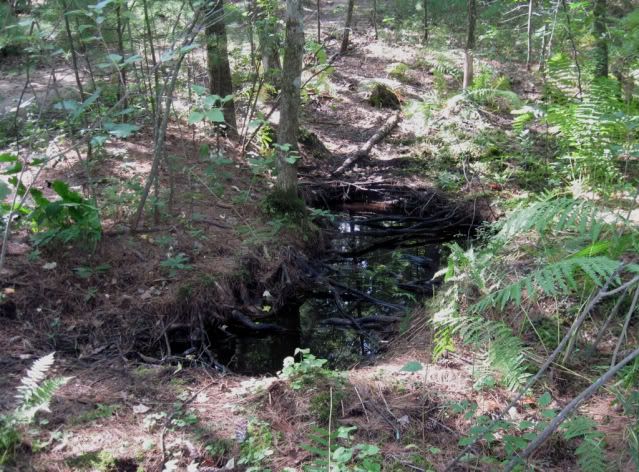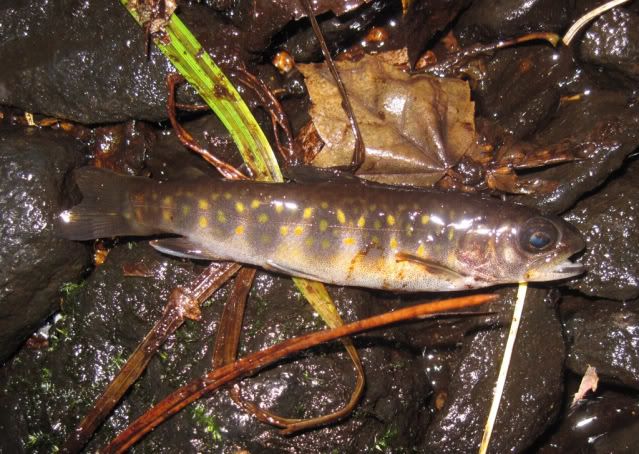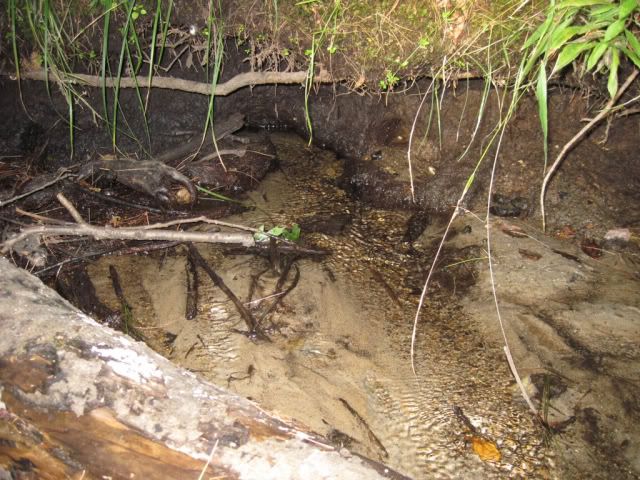eastern brook trout ecology/conservation in compromised systems
#22
 Guest_FishheadDave_*
Guest_FishheadDave_*
Posted 27 September 2010 - 03:25 PM
Dave, it's good to see you chime in here! Man those are some awfully nice looking char!
I'm excited to get involved. I've been a closet NANFA member for years, but this is the first I've discovered the forums. So you're a 'char' guy as opposed to "charr" guy?
#23
 Guest_mikez_*
Guest_mikez_*
Posted 28 September 2010 - 09:54 AM
My little brother, my favorite brother
Only problem with pics like that, when you try to talk brookie conservation, people want them a few of those, and right quick.
Here's my spring, or a short section:
This was my first view, from the heavily traveled path. Maybe six feet long, seeps from the sand and goes down lower left into what looks like an animal burrow. Tiny wakes had me thinking baby pickeral.

One darted under a root and I scooped it with my hands for id.

This is one of the two permanent brooks which feed the main brook. If you were familiar with 80% of the short small streams in the area, you'd look at it on a map, or in person and say no way have trout survived.

But there were those crazy wakes again! At one point it was jokingly suggested I was hallucinating, but this guy stranded himself in a dead end and flipped out of the water for a second.

So why did trout survive against all odds and in the driest summer of my memory? I'm guessing this had something to do with it.

That spring came into the brook at a right angle out of the clay in what looked for all the world just like a leak from a water distribution pipe. At close to worst case water level, that's coming out with enough flow to sort the sand and gravel a good ways below.
That's what saved those brookies these 10,000 years and more.
#25
 Guest_mikez_*
Guest_mikez_*
Posted 28 September 2010 - 11:07 AM
nice looking little brookies. You need some size 18 flies/hooks for them
quite the stream you found, it does not look like much until, as you observed, tiny wakes could be seen
I'm very seriously considering a voucher for the Harvard collection. Would have to be a dry, preferably a New England original...
Seriously, what's easily obtainable that would preserve a three inch trout? How's that whole thing work? Do I kill 'em first?
BTW, there is no length limit on trout in Ma.
#26
 Guest_fundulus_*
Guest_fundulus_*
Posted 28 September 2010 - 12:55 PM
#27
 Guest_Newt_*
Guest_Newt_*
Posted 28 September 2010 - 01:05 PM
That's a neat spring. I'm continually astonished at how small a stream trout will occupy.
Unfortunately, in my area the trouble is more with keeping the trout out then keeping them in. I just discovered TWRA has started put-and-take trout stocking in Whiteoak Creek, one of the most beautiful lower Tennessee River tributaries and home to really neat fish such as the blotchside logperch, slabrock darter, blenny darter, sawfin shiner, redfin chub, and mountain shiner, all of which could be negatively impacted by the trout. Just so people won't have to drive a few hours east to fish for trout, or settle for the abundant bass, walleye, catfish, and sunfish in the area....[/rant]
#28
 Guest_brookiechaser_*
Guest_brookiechaser_*
Posted 29 September 2010 - 09:53 AM
That's a neat little spring you have there. It is amazing that trout can survive in what seems like unsuitable habitat when they have a good stable supply of cold, clean water year round even during droughts. That's crazy too that there fish in that isolated patch of exposed water there. I really do think that in those types of streams (i've dealt with one) that go underground then reappear that brook trout MAY move through the underground stream from one opening to another. My suggestion is to PRESERVE the springs and try to increase canopy cover as far downstream from the springs as possible. That will increase the suitable thermal habitat available. How large is the "mainstem" creek you have there?
#29
 Guest_mikez_*
Guest_mikez_*
Posted 29 September 2010 - 10:48 AM
Newt, I considered your points. For one, the state has been made aware of the situation and they have no immediate plans to sample or collect. They have a list they keep of "Cold Water" habitat but beyond that, they focus on systems that have potential to yield angler hours. This one currently does not rank high enough.
As far as genetic research, I hope some grad student will get interested and come here and study them. There's lots of interest in brook trout genetics as you know and these isolated systems could be unique. Mine certainly have been isolated for 300 years since the first mills. Who knows what the stockies contribute. But let them collect their own when they need them.
I can't stand the thought of shocking those tiny fish. I know it's supposed to be safe but come on, I saw Cuckoo's Nest.
BC, the pic of the spring only represents one small section. There's a longer stretch which I will post soon. Also, it looks as if the spring runs as a stream when the water table is high. In addition, the valley it cuts through the sand shows the stream was substantial at one time. Those tiny trout are probably the remenants of what was once a year round stream population. Killing the beaver and drilling wells lowered the aquifer and drove the stream underground.
The main brook looks so nice. It would be very fun to flyfish. It's got three large stone dams which heat and fertilize the water into a nasty green mess.
The dams gotta go but abutters are bazillionaires who have clout and they like their ponds.
#31
 Guest_brookiechaser_*
Guest_brookiechaser_*
Posted 29 September 2010 - 12:27 PM
#32
 Guest_FishheadDave_*
Guest_FishheadDave_*
Posted 29 September 2010 - 01:19 PM
I understand the concern shocking fish in such an isolated population, but an experienced electrofisher would be able to manipulate the settings in a way to minimize to nearly zero the amount of causalities. I shocked lots of streams that looked quite similar. Very rarely did I ever have ANY trout not recover from stress of being shocked AND anesthetized in clove oil for weighing and measuring. I respect your decision to not shock....just throwing that out there.
I'll chime in as well. Someone properly trained in backpack electrofishing (there is a whole NCTC course to this regard - I found it very informative) could collect fish in this type of habitat with extremely low mortality rates. Water temperatures, shocker settings, and crew experience all play a large role in determining mortality rates. Most of our brook trout sampling is done with continuous DC current (least harmful), and even after anesthesia and tagging, we see apparent mortality rates of <0.5%. Out of over 7000 fish we've PIT tagged, almost every single mortality was the result of aggressive netting, as opposed to the electricity.
On a side note, clove oil is being phased out of fisheries research. One of the minor isomers of eugenol (the active ingredient) was apparently found to be carcinogenic in lab studies (granted the doses were extreme, but no matter...). MS-222 is promoted as an alternative, but its also nasty stuff, and isn't approved for use on fish which could be legally harvested within 21 days. As far as Im aware, the anesthesia issue is a tricky subject at the moment, at least until someone comes out with a new chemical to use.
#33
 Guest_fundulus_*
Guest_fundulus_*
Posted 29 September 2010 - 03:47 PM
#34
 Guest_ashtonmj_*
Guest_ashtonmj_*
Posted 29 September 2010 - 07:02 PM
Crazy looking streams Mike. Reminds me of a very few remaining places on western shore, Coastal Plain of Maryland, that are primarily groundwater fed, cool water in the summer, but the lower reaches 3rd-4th order go dry to standing pools. Brook trout are long gone though.
#36
 Guest_mikez_*
Guest_mikez_*
Posted 30 September 2010 - 07:40 PM
I see plenty of chance to use the backpack shocker. There may be more going on than anyone realizes in the main brook. A big bird told me I need to get the 5 weight out and do some stream surveys of my own. I don't think anyone has ever looked close enough. Limited electroshocking was done in warm weather but not fall or winter. The state does not stock the stream so most trout fishermen ignore it.
As it is, the property I adopted seems to have inherited the best stretches of both feeder streams without realizing it.
I walked with a couple folks from the trustees that own the land and a couple TU guys and their minds were blown by the spring. They knew about the trout in the feeders but not how many.
No one knew anything about springs.
There's a gulf in philosophy re the dreaded beave that I see as critical. Even after seeing the spring and hearing my water guy rant about the aquifer, the TU guys are adament about waging war against beaver. They are not seeing outside the stream flow based standard doctrine. The water in the beaver ponds is obviously hot in summer, as is immediately adjacent downstream brook. They're not getting that it was only the seeps and springs that provided the thermal refuge. Where does the water come from that feeds seeps and springs? It comes from upslope. All the best and biggest beaver ponds are all directly upslope of the places I believe provided the summer refuge. It was most certainly not stream flow that saved them.
The trustees tend to view diversity as the ultimate goal and view the beaver as the natural agent of forest succession and a boost for many plants and animals. I tend to subscribe to that view myself but not to the point that I would stress the trout at spawning time. There is a lot of silt.
It's all so complicated. Good news is how much protected land is joined around the system. Now if everybody could get on the same page...
#38
 Guest_mikez_*
Guest_mikez_*
Posted 01 October 2010 - 06:39 AM
In my experience TU people have a very rigid way they feel everything should be done with stream management. A one-size-fits-all approach is not so useful in most situations.
They have some smart folks. I'm hoping they can be educated. The group as a whole has a proven history of stream improvement work, cash money and a healthy corp of free labor.
In perspective, at age 10, in 1972, I was wearing waders and pulling trash, building wing dams and planting willows in Catskill trout streams with TU in a time before people had even heard of the Clean Water Act. Well, I personally did more chasing snakes and watching johnny darters and ease dropping on grown up naturalists then real work.
In the mish mash of small local conservation groups, some strongly dominated by abutters with agendas, it's good that the trout have a champion with clout. Even among the best conservationists in the various groups, there doesn't seem to be an appreciation for how unique the trout are. They're not on any lists while the number of state listed plants and animals benifiting from the beaver is impressive.
Hopefully balance will be found.
I'd like to see as much water as possible held back for the aquifer but still like to see some scour to clean off the gravel. Good clean spawning sites seem rare to my eye, but I grew up watching trout in a healthy system. These guys must have found a way to hang on this long.
Now that rain has come, I will be trying to find the spawning fish.
#39
 Guest_FishheadDave_*
Guest_FishheadDave_*
Posted 01 October 2010 - 09:03 AM
They have some smart folks. I'm hoping they can be educated. The group as a whole has a proven history of stream improvement work, cash money and a healthy corp of free labor.
In perspective, at age 10, in 1972, I was wearing waders and pulling trash, building wing dams and planting willows in Catskill trout streams with TU in a time before people had even heard of the Clean Water Act. Well, I personally did more chasing snakes and watching johnny darters and ease dropping on grown up naturalists then real work.
In the mish mash of small local conservation groups, some strongly dominated by abutters with agendas, it's good that the trout have a champion with clout. Even among the best conservationists in the various groups, there doesn't seem to be an appreciation for how unique the trout are. They're not on any lists while the number of state listed plants and animals benifiting from the beaver is impressive.
Hopefully balance will be found.
I'd like to see as much water as possible held back for the aquifer but still like to see some scour to clean off the gravel. Good clean spawning sites seem rare to my eye, but I grew up watching trout in a healthy system. These guys must have found a way to hang on this long.
Now that rain has come, I will be trying to find the spawning fish.
Beaver ponds are a complicated issue when it comes to brook trout. On one hand, they warm up quickly and generally are too warm for brookies in the summer (at least in most of the US). On the other hand, these impoundments can be very important to brook trout growth early in the spring, as these habitats seem to become productive much earlier in the year. At one of my study sites in Maine, many of our biggest brook trout used a large beaver meadow in the spring and grew rapidly. By mid-summer, these waters sometimes approached 30 Celsius, which would be lethal to a brook trout in very short order. But, these fish moved into alternative habitats which provided thermal refugia -- springs in nearby tributaries.
So I guess my point is this - as long as there are decent coldwater refugia nearby, beaver meadows may be beneficial for brook trout, even beyond their role in groundwater recharge. In streams that lack significant stream flow, beavers may be more of an 'issue'. But the fact of the matter is that beaver impoundments provide important habitat for many other wildlife species, so I'm not very comfortable with the idea of controlling beavers to promote brook trout. Controlling beavers is also a short-term local 'fix' to a widespread and long-term decline, and in any case I don't see it being a viable long-term strategy.
Reply to this topic
1 user(s) are reading this topic
0 members, 1 guests, 0 anonymous users







